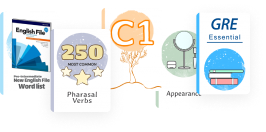Contrações Para Iniciantes

O Que São Contrações?
Contrações são formas abreviadas de palavras, onde duas palavras são combinadas e algumas letras são removidas.
Como Fazer Contrações?
Para fazer contrações, um apóstrofo (') é usado no lugar da letra removida.
I’m here. → I am here.
Estou aqui.
She’s here → She is here.
Ela está aqui.
Quando Usar Contrações?
Contrações são usadas em diferentes contextos. Aqui estão alguns dos principais:
Verbos 'To Be' Contraídos
As várias formas do verbo 'to be', incluindo 'am', 'is' e 'are', podem ser contraídas. Por exemplo:
She’s coming. → She is coming.
Ela está vindo.
We’re talking → We are talking
Nós estamos conversando.
forma completa | forma contraída |
|---|---|
I am (sou/estou) | I'm |
uou are (és/é/estás/está) | you're |
it is (é/está) | it's |
he is (é/está) | he's |
she is (é/está) | she's |
we are (somos/estamos) | we're |
you are (sois/estais) | you're |
they Are (são/estão) | they're |
Auxiliares e Modais Negativos
'Not' é usado para tornar os verbos negativos. Para usar uma forma contraída do verbo negativo, a letra 'o' é removida e um apóstrofo é usado em seu lugar. Isso pode ser feito tanto com verbos modais quanto auxiliares.
forma completa | forma contraída |
|---|---|
are not | aren't |
is not | isn't |
was not | wasn't |
were not | weren't |
do not/does not | don't/doesn't |
did not | didn't |
have not/has not | haven't/hasn't |
had not | hadn't |
Aviso!
Para usar a forma contraída de 'I am not', apenas o verbo 'to be' pode ser contraído, não o marcador negativo. Então a forma contraída será 'I'm not' em vez de 'I amn't'.
Verbos modais também são tornados negativos usando 'not'. Como os auxiliares, eles podem ser contraídos removendo a letra 'o' de 'not'. Por exemplo:
She shouldn't go. → She should not go.
Ela não deveria ir.
He can’t sing. → He cannot sing.
Ele não pode cantar.
Quiz:
What is the correct contraction of "I am"?
I'am
Iam
I'm
Im
Which of these sentences uses the correct contraction?
I amn't going.
They’re not here.
She dont like it.
Were going.
Which is the correct contraction?
He’s not happy with the results.
He isn’t happy with the results.
He’s’nt happy with the results.
1 and 2
Fill in the blanks with the contracted form of the verbs in parentheses to complete the story.
Yesterday, I was at the park with my friend, Sarah. She was excited because (1) she
(be) going to a concert tonight. I asked her if she had any tickets, but she said, “I (2)
(do not) have them yet. I think I’ll buy them later.”
We were talking when her brother, Tom, arrived. He (3)
(did not) want to join us. He said, “(4) I
(be) busy today. I have to study for my exams.” Sarah said, “That’s too bad! You (5)
(should not) miss the concert, Tom.”
Fill in the table with the correct contracted forms.
you are | |
it is | |
we are | |
were not | |
does not | |
should not | |
cannot |
Comentários
(0)